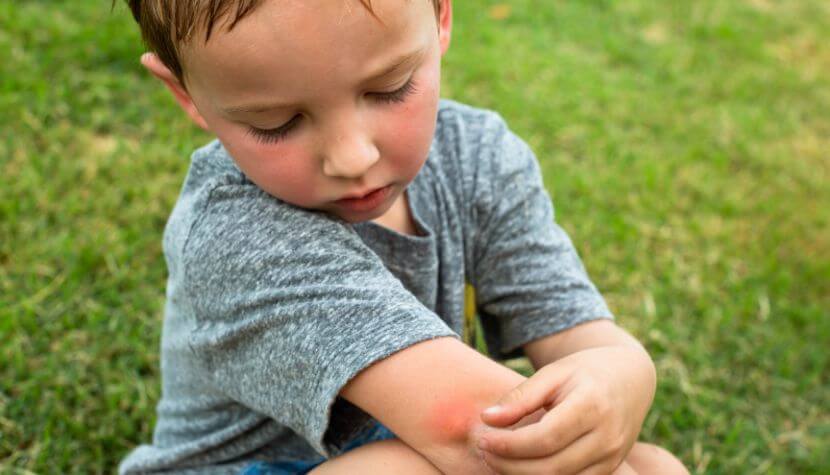
It’s summertime—sunshine, fresh air, and, unfortunately, bugs. Whether it’s mosquitoes, bees, ticks, or fire ants, bug bites in children are practically a rite of passage during outdoor play. While they’re often harmless, knowing how to manage them at home—and when to seek medical care—can give you peace of mind and keep your child comfortable and safe.
What Do Bug Bites and Stings Look Like?
Bug bites often show up as red, swollen, itchy, or painful bumps. This is your child’s immune system reacting to the insect’s saliva or venom—not necessarily a sign of allergy. Most reactions are mild and go away on their own. Normal symptoms include:
- Redness
- Swelling that peaks within 48 hours and may last up to a week
- Itching or mild discomfort
A few kids may also get sneezing, an itchy nose, or mild hives. In these cases, oral Benadryl can help ease symptoms. Figuring out what kind of bug caused the bite isn’t that important. What matters more is knowing how to care for it and when to get help.
When to Seek Emergency Help
Sometimes, bug bites or stings trigger severe allergic reactions (anaphylaxis). Seek emergency medical care immediately if your child has:
- Trouble breathing or wheezing
- Pale skin or fainting
- Swelling of lips, tongue, or throat
- Confusion or severe hives
- Rapid onset of any of the above after a bite or sting
These symptoms require an epinephrine injection and calling 911 right away. Children with known allergies may benefit from allergy shots in the long run.
Other Concerning Symptoms to Watch For
If your child develops any of these symptoms after being bitten or exposed to a tick, contact your doctor. These could signal insect-borne illnesses, such as Lyme disease, West Nile virus, or Zika.
- Fever lasting more than 4 days
- Target-shaped (“bullseye”) rash
- Severe headache or neck stiffness
- Joint swelling or pain
- Facial drooping
- Persistent vomiting, belly pain, or signs of dehydration (like peeing fewer than 3 times/day)
What About Skin Infections?
Sometimes, the bite site becomes infected, especially if your child scratches it frequently. This is called cellulitis, and it usually appears two or more days after the bite. Signs of cellulitis include:
- Increasing pain, redness, warmth, or swelling
- Skin that looks shiny or stretched
- Red streaks moving from the bite
- Fever, chills, or swollen lymph nodes
This requires antibiotics, so you must see your healthcare provider if these symptoms appear.
At-Home Care for Bites and Stings
Most bites don’t need anything fancy. Here’s how to treat them at home. To reduce pain and swelling:
- Use cold packs for up to 20 minutes at a time
- Give acetaminophen (aka Tylenol) or ibuprofen if needed
To relieve itching:
- Apply hydrocortisone cream or calamine lotion
- Oral Benadryl tends to work better than the cream
- Covering the bite can reduce scratching
Avoid using topical antibiotic ointments unless directed by your healthcare provider—some children may react to them. Frequent handwashing and cleaning the area with soap and water is usually enough.
How to Remove a Stinger
If your child is stung by a bee, the venom sac may continue to release venom if the stinger isn’t removed. Here’s how to do it:
- Scrape it out gently with a credit card or similar object.
- Clean the area with soap and water or rubbing alcohol.
- For relief, apply a baking soda paste (made by mixing baking soda with water) to neutralize the venom.
How to Remove a Tick
Ticks like to hide in hairlines, armpits, groins, and behind the ears. After time outdoors, especially in wooded or grassy areas, always shower and do a full-body check. To remove a tick:
- Use tweezers to grab it as close to the skin as possible
- Pull straight out slowly
- Avoid folklore methods (matches, nail polish, petroleum jelly)
A tick usually has to be attached for at least 24 hours to spread Lyme disease.
Insect Repellent 101
DEET is the gold standard for repelling insects like mosquitoes, ticks, gnats, fleas, and more, according to the American Academy of Pediatrics. Key facts about DEET:
- Safe for children 2 months and older
- Use a 10–30% concentration depending on how long you need protection
- 10% lasts ~2 hours
- 30% lasts ~5 hours
- Apply only to exposed skin and outer clothing—not under clothes
- Avoid hands, eyes, and mouth
More Ways to Keep Bugs Away
- Avoid scented soaps, perfumes, and hairsprays
- Steer clear of standing water, uncovered food, and blooming flowers
- Dump or drain birdbaths, planters, buckets, and tires with water
- Repair window screens
- Dress kids in neutral, unscented clothing (not bright or floral)
- Use long sleeves, pants, and socks, especially at night
- Add a hat for extra protection in tick-prone areas
- For babies under 2 months, use mosquito netting over strollers
Bug bites and stings are part of childhood, but with a little knowledge and preparation, they don’t have to be a source of stress. Know the signs of serious reactions, treat the mild ones wisely, and enjoy the outdoors safely!
Need Expert Care? Community Care is Here to Help
While most bug bites in children are minor, some may require professional attention. If you’re unsure how to manage a bite or sting, or if your child is experiencing unusual symptoms, our trusted pediatricians are here for you. Our pediatric teams offer compassionate, expert care to help your child feel better—fast. Learn more about our locations and providers today.
